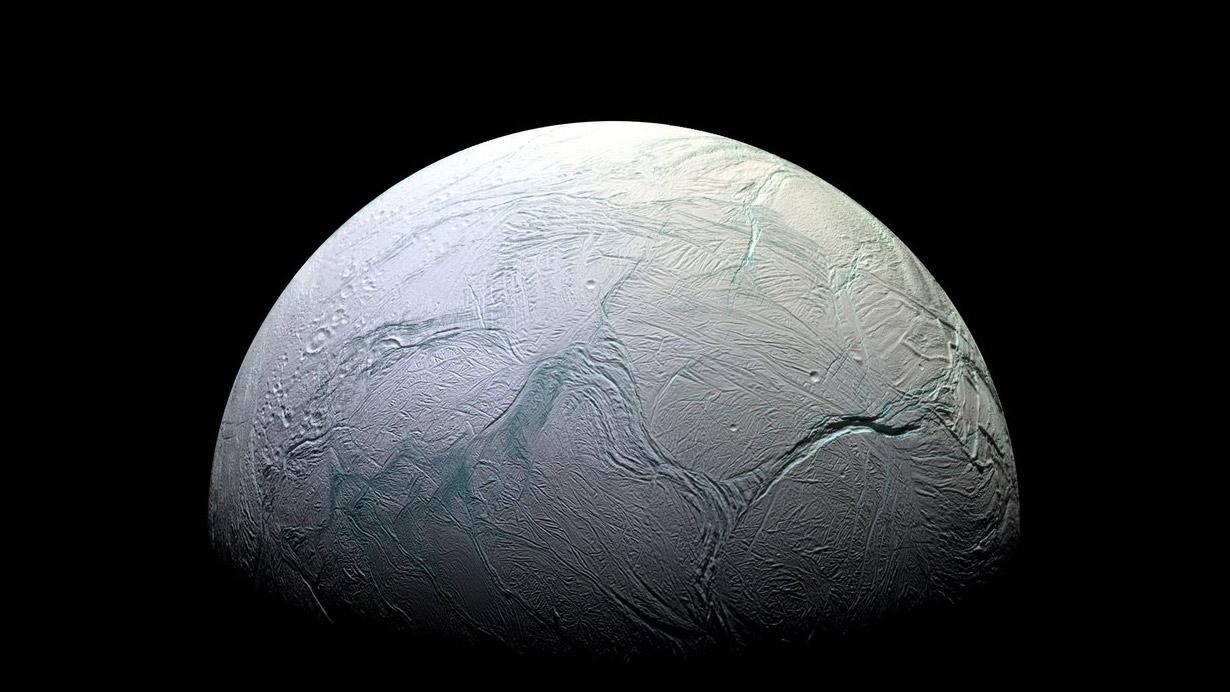Could there be life on Saturn’s moon, Enceladus? New research raises the possibility.
This is a view of Enceladus, Saturn's sixth-largest moon, taken by the Cassini spacecraft.
New research from NASA’s Cassini mission has all eyes on Enceladus, Saturn’s sixth-largest moon. The research, recently published in Science magazine, indicates that plumes of vapor escaping from cracks in the moon’s icy shell are full of molecular hydrogen, the fuel for microbial life.
As Scott Bolton, a co-author and mission co-investigator from the Southwest Research Institute, explains: “Hydrogen’s the most common element in the whole universe, but we don’t expect a lot of it sitting on Enceladus.” That’s because Enceladus is too small to trap large reserves of hydrogen in its gravity field, he says.
The inference, of course, is that hydrogen is being produced somewhere on the Saturnian moon. But how? Bolton and his colleagues have an idea — one that could link the global ocean beneath Enceladus’ ice shell with the life-sustaining deep oceans of Earth.
“The idea that we’ve proposed — and we’ve researched a lot of different ideas trying to come up with an alternative theory — is that actually there’s hydrothermal activity going on deep in the ocean on Enceladus, and it may be producing white and black smokers, kind of like what we see on Earth,” Bolton says.
He explains that on Earth, smokers are deep hydrothermal vents that put out white or black “smoke” underwater, depending on their sulfur content: “Basically, what you have is you have minerals that are very rich in iron interacting with water.” That chemical process forms new minerals, he says — and releases hydrogen.
“In other words, under the deep sea, the water meets the rock, and some chemistry occurs, and hydrogen is released,” he explains. At least, that’s how it happens on Earth — and Cassini data has already shown that the ocean on Enceladus lies above a rocky core.
On Earth, scientists believe that hydrothermal vents were an early source of life. Today, the areas around deep sea vents teem with species that we’re still discovering.
“You don’t need any sunlight at all,” Bolton says. “You just have the microbes basically feeding off of this hydrogen, and that’s its energy source. And around that region on the Earth in these hydrothermal vents, you find little spider crabs, little shrimp, all kinds of different kinds of mussels.”
To find a shrimp in Enceladus’ ocean would take a submarine, but Bolton says there’s another place we can look for life: in the water vapor spewing through cracks in the moon’s ice hull.
“If you can fly a spacecraft through that water mist, you can go in and measure whether there’s microbes, and amino acids, and other kinds of things that might be present in that water,” he says.
Bolton says that a follow-up probe to Enceladus hasn’t yet been approved, but a mission to one of Jupiter’s moons, Europa, is currently in the works. “It would, hopefully, fly through these plumes,” Bolton says.
“We’ve seen some plumes coming out of the ice of Europa through Hubble telescope images. And so we would look for something similar as to what we just saw on Enceladus, and even more.”
UPDATE: A previous version of this story incorrectly stated Europa was a moon of Saturn, it is a moon of Jupiter.
This article is based on an interview that aired on PRI's Science Friday. Watch a video about the discovery here.
We want to hear your feedback so we can keep improving our website, theworld.org. Please fill out this quick survey and let us know your thoughts (your answers will be anonymous). Thanks for your time!
